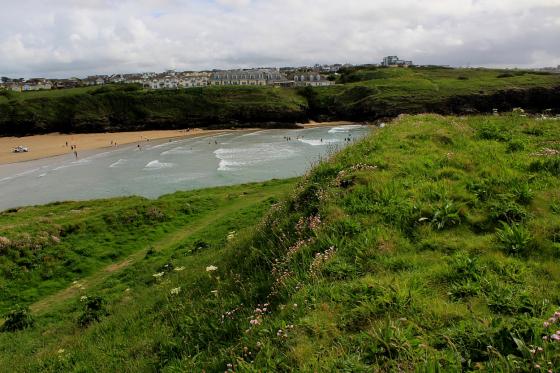
Skull in Padstow Museum from the site at Constantine

Skull in Padstow Museum from the site at Constantine

Recent (2025) interpretation boards have recently been erected. This one shows the church/chapel as it once may have been.

The kitchen middens are now clearly visable near the wooden steps near Constantine Island

This is taken from a golf tee on the side of the Kitchen Midden to the West of the ruin.

Looking into ruined tower from the East. As you can see it is very overgrown compared to the old illustrations.

map dated 1912 showing location of the church and other nearby sites.

sketch dated 1912
I visited this site on a weekend at Constantine Bay. It is very overgrown and one of the side walls has been propped up to stop it collapsing. It wasn’t obvious where the reputed ‘sacred stone’ (see Misc section) was due to the foliage on the site. The biggest lump under the tower just looked like a large, flat step, but looking at the illustration this is where it would be. This stone is just visible in the first photo. It does seem a wierd place to go to the trouble of building a church, and one can imagine this secluded hollow in the sand could have been a sacred place for a long time beforehand. It was obviously a good place to gather and feast on shellfish, as the kitchen midden would suggest.
There is also a Well near the ruin, but I was too scared to venture out across the golf course!
Access: It is in the middle of Trevose golf course, and unless you like the feeling of being under fire then it is best to go to the Golf (and Country Club!!) Reception in Constantine Bay and ask a nice man to point the way through the flying golf balls.
Once at the church you are tucked in the middle of a mound and it is quite peaceful!
There are other sites of interest in the area which are worth a look; Cataclews Point with it’s 3 burial cist barrows (see Ficklefingers post below), and, further around the coast path in Harlyn Bay, is a burial ground which has yielded many interesting finds and was thought to be in use from pre-history up until just before the Roman invasions. (See links section)
I visited the 3 cists marked on the posted map. You can find flint microliths etc here. I found evidence of flint knapping easily. Worth a look, all around the mounds which are easily found. All 3 mounds have been dug into in the past. This is obvious when you look at them. Access is easy as footpath goes right past them. It is possible that there were more mounds than the 3 there now.
Some notes from a book called “Harlyn Bay and the discoveries of its Prehistoric remains” by R. Ashington Bullen 1912
The ruins of Constantine church stand near a kitchen midden. It was built in a hollow in the sand . Underneath the ruined tower is a large boulder of Cataclew stone (plate 20) weighing apparently nearly a quater of a ton. The nearest locality for this rock is Cataclew (fig 14) about a mile and a half distant in a straight line.
This stone seems to have been a sacred object around which the tower was built, perhaps 1600 hundred years or more ago. We have a similar instance at Maplescombe Church near Faringham, Kent in which is a large mass of tertiary conglomerate at the N.E. corner. And Prof T. Rupert Jones F.R.S., considers the so-called Chair of Bede at Jarrow Church to have been a sacred stone of an early date, but known to have been chiselled by modern masons into its present rectangular shape.
If the whole surrounding mound at Constantine Church is a continous kitchen midden, as it seems likely, consisting of successive accumulations, the great boulder marked the meeting point for whatever religious or ceremonial rites were practised. the Christian Missionaries who built Constantine Church made the spot the centre for the new religion, including the stone within their edifice in a position of honour.
Summary of the excavation of one of the aforementioned cists on Cataclews Point near Constantine Bay.
Summary of excavation and finds at Harlyn Bay Prehistoric Burial Ground (near Constantine Bay)


















































